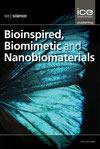穆萨提取物制备纳米乳胶凝胶的体外动力学及抗菌作用研究
IF 0.6
4区 工程技术
Q4 ENGINEERING, BIOMEDICAL
引用次数: 0
摘要
本研究旨在以麝香叶提取物为原料制备纳米乳液。以乙醇和氯仿为溶剂,比例为1:8 (%w/v)。DL- α -生育酚经GCMS鉴定为具有潜在生物活性的主要成分。在伪三元图的基础上,优化了Smix(表面活性剂:Co-表面活性剂)比例为1:1的最佳配比。对制备的纳米乳液的物理外观、pH值、涂抹性和膨胀指数进行了评价。外观呈浅黄色-白色,在pH值5-5.8范围内呈半透明。对引起头皮屑的微生物(表皮葡萄球菌和马拉色菌)进行了抗菌研究。体外研究了EG2、EG4、CG2和CG3的优化配方。EG2在12 h后释药率为94.28%,R2为0.99。动力学优化后的配方EG2具有良好的展涂性能,可达12.2 (g cm) s−1,膨胀指数为64%。本文章由计算机程序翻译,如有差异,请以英文原文为准。
Formulation of Nanoemulgel from Extracts of Musa acuminata: In-Vitro Kinetics and Antimicrobial Studies
The study was intended to formulate nanoemulgel from the leaf extract of Musa acuminata. Ethanol and Chloroform were used as solvents in the ratio of 1:8 (%w/v). DL- alpha-Tocopherol, characterized by GCMS, was identified to be the major component with potential biological activities. Based on a pseudo ternary plot, the 1:1 Smix (Surfactant: Co- Surfactant) ratio was optimized as it posed maximum regions of emulsion. The prepared nanoemulgel was evaluated for physical appearance, pH, spreadability, and swelling index. The appearance was pale yellowish-white, translucent within a pH range of 5-5.8. Antimicrobial studies were performed against dandruff-causing microbes (Staphylococcus epidermidis and Malassezia furfur). Invitro studies were carried out for optimized formulations of EG2, EG4, CG2, and CG3. The drug release of 94.28% after 12 h with Higuchi plot of R2 value as 0.99 was observed for EG2. The kinetically optimized formulation, EG2 was found to have good spreadability of 12.2 (g cm) s−1 and a swelling index of 64%.
求助全文
通过发布文献求助,成功后即可免费获取论文全文。
去求助
来源期刊

Bioinspired Biomimetic and Nanobiomaterials
ENGINEERING, BIOMEDICAL-MATERIALS SCIENCE, BIOMATERIALS
CiteScore
2.20
自引率
0.00%
发文量
12
期刊介绍:
Bioinspired, biomimetic and nanobiomaterials are emerging as the most promising area of research within the area of biological materials science and engineering. The technological significance of this area is immense for applications as diverse as tissue engineering and drug delivery biosystems to biomimicked sensors and optical devices.
Bioinspired, Biomimetic and Nanobiomaterials provides a unique scholarly forum for discussion and reporting of structure sensitive functional properties of nature inspired materials.
 求助内容:
求助内容: 应助结果提醒方式:
应助结果提醒方式:


